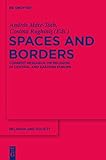Spaces and Borders : Current Research on Religion in Central and Eastern Europe / ed. by András Máté-Tóth, Cosima Rughinis.
Material type: TextSeries: Religion and Society ; 51Publisher: Berlin ; Boston : De Gruyter, [2011]Copyright date: ©2011Description: 1 online resource (278 p.)Content type:
TextSeries: Religion and Society ; 51Publisher: Berlin ; Boston : De Gruyter, [2011]Copyright date: ©2011Description: 1 online resource (278 p.)Content type: - 9783110228137
- 9783110228144
- 200.943 23
- BL980.C39 S63 2011eb
- online - DeGruyter
- Issued also in print.
| Item type | Current library | Call number | URL | Status | Notes | Barcode | |
|---|---|---|---|---|---|---|---|
 eBook
eBook
|
Biblioteca "Angelicum" Pont. Univ. S.Tommaso d'Aquino Nuvola online | online - DeGruyter (Browse shelf(Opens below)) | Online access | Not for loan (Accesso limitato) | Accesso per gli utenti autorizzati / Access for authorized users | (dgr)9783110228144 |
Frontmatter -- Table of Contents -- Introduction -- Experiencing Religion -- The Vague Borders of New Age. Methodological Comparison of Studies Concerning New Age in Central and Eastern Europe -- Values and Ethnicity – Religious Conversions of Roma in Eastern Slovakia to the Watchtower Society -- The Negotiation of Borders between “Religion” and “Spirituality”. The Case of the Czech Spiritual Milieu -- ISKCON Folk Devils Fight Back. The Dynamics of Counter-Stigmatization Strategy -- Strategies of Religious Elites -- Muslims, Bosnians and Bosniaks Shaped among Sarajevo, Sandžak and Belgrade -- Acculturation of Hinduism and the Czech Traditions of Yoga. From Freedom to Totality and Back Again -- The Interaction between Orthodox Church and State in Post-Soviet Russia. Identifying the Borders of Political Development -- Clericalization of Nationalism. Interpreting the Religious Rivalry between Serbian and Montenegrin Orthodox Churches, 1989–2009 -- Religion and Politics -- Freedom of Religion in the Baltic States: Sociological and Legal Analysis -- What Do We Want from Religion? Religiosity and Social Expectations in Central and Eastern Europe -- Confronting Religion with National Pride Values: Comparative Evidence from Eastern and Western Europe -- Attitudes towards National Identity and National Values among Polish Catholic Youth -- Religious Determinants of Democratic Values -- Political Secularity of Religious People in European Countries -- Quasi-Religious Character of the Hungarian Right-Wing Radical Ideology. An International Comparison -- List of Contributors -- Index of Objects
restricted access online access with authorization star
http://purl.org/coar/access_right/c_16ec
People observe and transgress religious borders when they relate with faith and other faiths, when they shape communities, when they make decisions. A group of researchers have joined an inquiry into the forces of religious closure and openness in present-day Central and Eastern Europe. The volume is a result of a research community constituted within the REVACERN project – Religion and Values in Central and Eastern Europe Research Network, supported by the 6th framework program of the European Union. Chapters are structured in three sections, focusing on individual experiences of religion and spirituality, on religious elites, and on the interaction of religion with politics. Sociology, political science and history are triangulated to render a clear understanding of the individual experiences of religion and secularity, and of the strategic choices of religious and political elites, taking readers along an exploration of religious identity and otherness.
Issued also in print.
Mode of access: Internet via World Wide Web.
In English.
Description based on online resource; title from PDF title page (publisher's Web site, viewed 28. Feb 2023)


